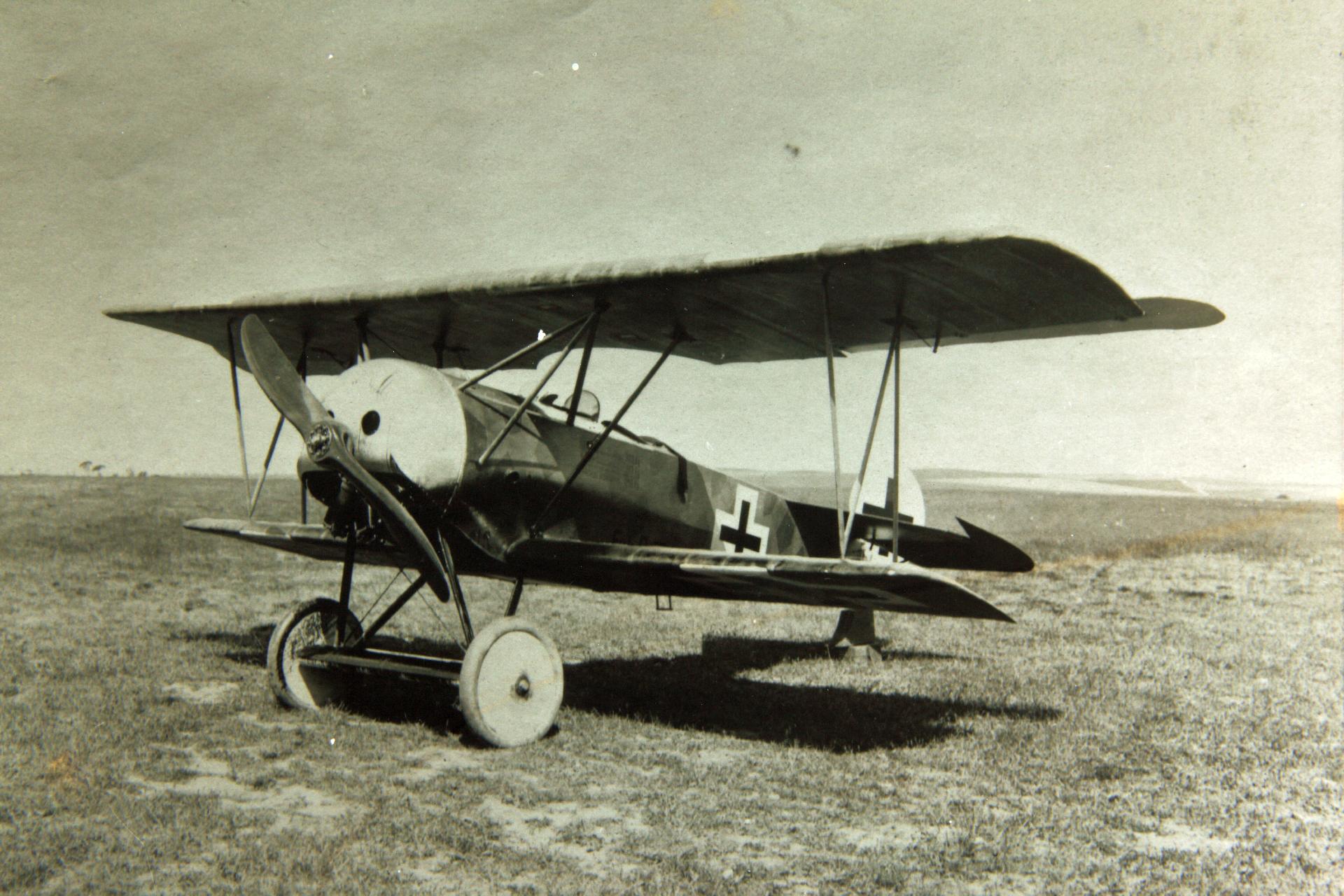Fokker D.VI on:
[Wikipedia]
[Google]
[Amazon]
The Fokker D.VI was a German fighter aircraft built in limited numbers at the end of World War I. The D.VI served in the German and Austro-Hungarian air services.
 The new aircraft, designated D.VI, passed its ''Typenprüfung'' (official type test) on 15 March 1918.Weyl 1965, p. 271. The production aircraft utilized the Oberursel Ur.II, which was the only readily available German rotary engine. ''Idflieg'' authorized low level production pending availability of the more powerful Goebel Goe.III.Weyl 1965, p. 271. Deliveries commenced in April and ceased in August, after only 59 aircraft had been completed.Gray and Thetford 1962, p. 102. Seven aircraft were delivered to the Austro- Hungarian Air Service ( ''Luftfahrtruppen'').
In service, the D.VI was hampered by the low power of the Oberursel Ur.II.Weyl 1965, p. 271. Moreover, the lack of castor oil and the poor quality of "Voltol," an ersatz lubricant, severely reduced engine life and reliability. The D.VI remained in frontline service until September 1918, and continued to serve in training and home defense units until the Armistice.
The new aircraft, designated D.VI, passed its ''Typenprüfung'' (official type test) on 15 March 1918.Weyl 1965, p. 271. The production aircraft utilized the Oberursel Ur.II, which was the only readily available German rotary engine. ''Idflieg'' authorized low level production pending availability of the more powerful Goebel Goe.III.Weyl 1965, p. 271. Deliveries commenced in April and ceased in August, after only 59 aircraft had been completed.Gray and Thetford 1962, p. 102. Seven aircraft were delivered to the Austro- Hungarian Air Service ( ''Luftfahrtruppen'').
In service, the D.VI was hampered by the low power of the Oberursel Ur.II.Weyl 1965, p. 271. Moreover, the lack of castor oil and the poor quality of "Voltol," an ersatz lubricant, severely reduced engine life and reliability. The D.VI remained in frontline service until September 1918, and continued to serve in training and home defense units until the Armistice.

Design and development
In late 1917,Fokker-Flugzeugwerke
Fokker was a Dutch aircraft manufacturer named after its founder, Anthony Fokker. The company operated under several different names. It was founded in 1912 in Berlin, Germany, and became famous for its fighter aircraft in World War I. In 1919 t ...
built two small biplane prototypes designated V.13. These aircraft combined a set of scaled-down D.VII wings with a fuselage and empennage closely mirroring those of the earlier Dr.I.Gray and Thetford 1962, p. 103. The first prototype utilized an 82 kW (110 hp) Oberursel Ur.II rotary engine, while the second featured a 119 kW (160 hp) Siemens-Halske Sh.III
Siemens-Halske's Sh.III was an 11-cylinder, air-cooled counter rotary engine developed in Germany during World War I. The engine was a development of the earlier 9-cylinder Siemens-Halske Sh.I.
Design
The Siemens-Halske Sh.III was an 11-cylin ...
bi-rotary engine.Weyl 1965, p. 262.
Fokker submitted both prototypes at the Adlershof fighter trials in late January 1918.Weyl 1965, p. 264. At that time, Fokker reengined the first prototype with the 108 kW (145 hp) Oberursel Ur.III.Weyl 1965, p. 264. Pilots found the V.13s to be maneuverable and easy to fly.Weyl 1965, p. 269. '' Idflieg'' issued a production contract after the V.13s were ultimately judged to be the best rotary powered entries of the competition.Weyl 1965, p. 269.
Operational history
 The new aircraft, designated D.VI, passed its ''Typenprüfung'' (official type test) on 15 March 1918.Weyl 1965, p. 271. The production aircraft utilized the Oberursel Ur.II, which was the only readily available German rotary engine. ''Idflieg'' authorized low level production pending availability of the more powerful Goebel Goe.III.Weyl 1965, p. 271. Deliveries commenced in April and ceased in August, after only 59 aircraft had been completed.Gray and Thetford 1962, p. 102. Seven aircraft were delivered to the Austro- Hungarian Air Service ( ''Luftfahrtruppen'').
In service, the D.VI was hampered by the low power of the Oberursel Ur.II.Weyl 1965, p. 271. Moreover, the lack of castor oil and the poor quality of "Voltol," an ersatz lubricant, severely reduced engine life and reliability. The D.VI remained in frontline service until September 1918, and continued to serve in training and home defense units until the Armistice.
The new aircraft, designated D.VI, passed its ''Typenprüfung'' (official type test) on 15 March 1918.Weyl 1965, p. 271. The production aircraft utilized the Oberursel Ur.II, which was the only readily available German rotary engine. ''Idflieg'' authorized low level production pending availability of the more powerful Goebel Goe.III.Weyl 1965, p. 271. Deliveries commenced in April and ceased in August, after only 59 aircraft had been completed.Gray and Thetford 1962, p. 102. Seven aircraft were delivered to the Austro- Hungarian Air Service ( ''Luftfahrtruppen'').
In service, the D.VI was hampered by the low power of the Oberursel Ur.II.Weyl 1965, p. 271. Moreover, the lack of castor oil and the poor quality of "Voltol," an ersatz lubricant, severely reduced engine life and reliability. The D.VI remained in frontline service until September 1918, and continued to serve in training and home defense units until the Armistice.
Variants
* V.13/1 : First prototype, powered by a 108 kW (145 hp) Oberursel Ur.III rotary engine * V.13/2 : Second prototype, powered by a 119 kW (160 hp)Siemens-Halske Sh.III
Siemens-Halske's Sh.III was an 11-cylinder, air-cooled counter rotary engine developed in Germany during World War I. The engine was a development of the earlier 9-cylinder Siemens-Halske Sh.I.
Design
The Siemens-Halske Sh.III was an 11-cylin ...
rotary engine
Operators
; * ''Luftfahrtruppen'' ; * '' Luftstreitkräfte'' ; * Royal Hungarian Air Force - Postwar. ; * Romanian Air Corps - 6 captured during the war of 1919.Specifications

References
Notes
Bibliography
* Gray, Peter and Owen Thetford. ''German Aircraft of the First World War''. London: Putnam, 1962. * Taylor, Michael J. H. ''Jane's Encyclopedia of Aviation''. London: Crescent Books, 1993. . * Weyl, A.R. ''Fokker: The Creative Years''. London: Putnam, 1965. . {{Authority control 1910s German fighter aircraft D 06 Rotary-engined aircraft Biplanes Aircraft first flown in 1918